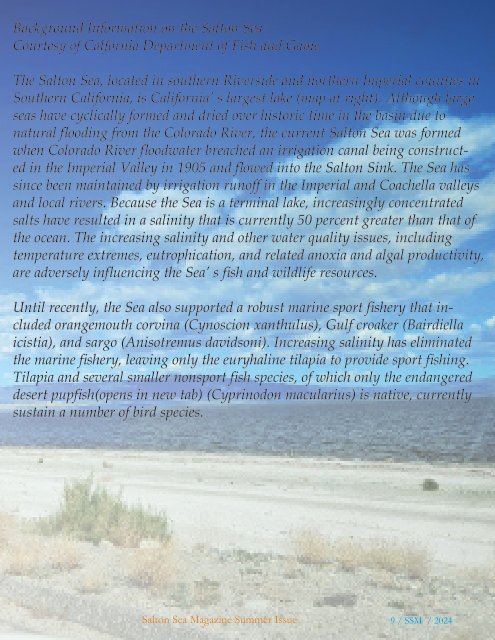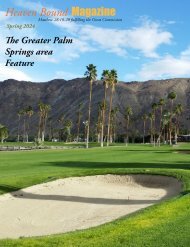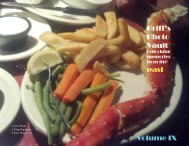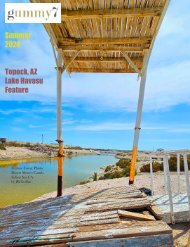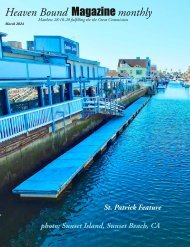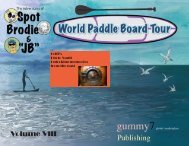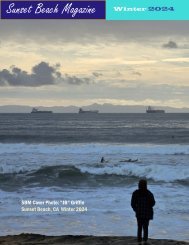Salton Sea Magazine Premier Issue Spring 2024
Welcome to the premier issue of Salton Sea Magazine Featuring Fun Events, People, Places, Ideas, Real Estate, Restaurants, Cool Places to Visit Golf, Updates to Salton Sea History, Preservation Efforts, Lithium Mining & More published by www.jbgmg.com Indio, CA 562.677.7452 email: jbgriffin@jbgmg.com
Welcome to the premier issue of Salton Sea Magazine
Featuring
Fun Events, People, Places, Ideas, Real Estate, Restaurants, Cool Places to Visit
Golf, Updates to Salton Sea History, Preservation Efforts, Lithium Mining
& More
published by
www.jbgmg.com
Indio, CA
562.677.7452
email: jbgriffin@jbgmg.com
You also want an ePaper? Increase the reach of your titles
YUMPU automatically turns print PDFs into web optimized ePapers that Google loves.
Background Information on the <strong>Salton</strong> <strong>Sea</strong><br />
Courtesy of Calfornia Department of Fish and Game<br />
The <strong>Salton</strong> <strong>Sea</strong>, located in southern Riverside and northern Imperial counties in<br />
Southern California, is California’ s largest lake (map at right). Although large<br />
seas have cyclically formed and dried over historic time in the basin due to<br />
natural flooding from the Colorado River, the current <strong>Salton</strong> <strong>Sea</strong> was formed<br />
when Colorado River floodwater breached an irrigation canal being constructed<br />
in the Imperial Valley in 1905 and flowed into the <strong>Salton</strong> Sink. The <strong>Sea</strong> has<br />
since been maintained by irrigation runoff in the Imperial and Coachella valleys<br />
and local rivers. Because the <strong>Sea</strong> is a terminal lake, increasingly concentrated<br />
salts have resulted in a salinity that is currently 50 percent greater than that of<br />
the ocean. The increasing salinity and other water quality issues, including<br />
temperature extremes, eutrophication, and related anoxia and algal productivity,<br />
are adversely influencing the <strong>Sea</strong>’ s fish and wildlife resources.<br />
Until recently, the <strong>Sea</strong> also supported a robust marine sport fishery that included<br />
orangemouth corvina (Cynoscion xanthulus), Gulf croaker (Bairdiella<br />
icistia), and sargo (Anisotremus davidsoni). Increasing salinity has eliminated<br />
the marine fishery, leaving only the euryhaline tilapia to provide sport fishing.<br />
Tilapia and several smaller nonsport fish species, of which only the endangered<br />
desert pupfish(opens in new tab) (Cyprinodon macularius) is native, currently<br />
sustain a number of bird species.<br />
<strong>Salton</strong> <strong>Sea</strong> <strong>Magazine</strong> <strong>Spring</strong> <strong>Issue</strong><br />
9 / SBM / 2023


